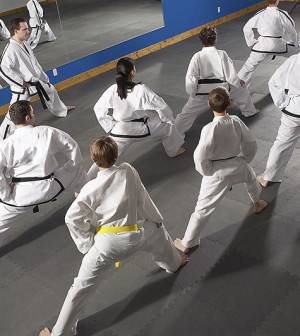- Skip Storing This Everyday Product in the Fridge Door
- Green Tea + B3 Pairing May Boost Brain Health
- Navigating Your Midlife Crisis: Embracing New Possibilities
- City Raccoons Showing Signs of Domestication
- Mapping the Exposome: Science Broadens Focus to Environmental Disease Triggers
- One Week Less on Social Media Linked to Better Mental Health
- Your Brain Changes in Stages as You Age, Study Finds
- Some Suicide Victims Show No Typical Warning Signs, Study Finds
- ByHeart Formula Faces Lawsuits After Babies Sickened With Botulism
- Switch to Vegan Diet Could Cut Your Greenhouse Gas Emissions in Half
Eczema Cases Rising Among U.S. Children: Report


A growing number of children are being diagnosed with the allergic skin condition eczema — but it can usually be eased with topical treatments, according to a new report.
Eczema is a chronic condition that usually starts in childhood, and causes patches of skin to become dry, inflamed and often intensely itchy.
And, studies have shown, eczema seems to be on the rise.
Based on a household survey by the U.S. Centers for Disease Control and Prevention, the prevalence of eczema among kids younger than 18 rose between 2000 and 2010: from around 9 percent to 17 percent among black children; from 5 percent to 10 percent among Hispanic kids; and from around 8 percent to almost 13 percent among white children.
“We don’t know for certain why that is,” said Dr. Anna Bruckner, one of the authors of the American Academy of Pediatrics (AAP) report.
Greater awareness of eczema and higher rates of diagnosis are likely part of it, according to Bruckner, who directs pediatric dermatology at Children’s Hospital Colorado.
“But the incidence of the [eczema] is probably increasing, too,” she said.
The AAP detailed the best ways to manage atopic dermatitis, more commonly known as eczema, in a report released online Nov. 24 in the journal Pediatrics.
The treatments described in the AAP report are not new, Bruckner said. But since so many kids have eczema — and there are so few pediatric dermatologists — all pediatricians need to be up to speed on the skin condition, according to Bruckner.
A pediatric dermatologist who reviewed the report agreed. “Pediatricians really need to understand this condition, and how to manage it,” said Dr. Ana Duarte, director of pediatric dermatology at Miami Children’s Hospital.
For most children with eczema, topical treatments and careful skin care are enough to control the condition, according to Bruckner.
Topical steroids are the mainstay for treating inflammation. Low-potency products, like hydrocortisone, usually work well — but parents often hesitate to use them, Bruckner noted.
“There are a lot of misconceptions about the safety of [topical steroids],” she said. Oral or high-potency topical steroids can cause side effects like thinning of the skin, or even growth retardation, Bruckner pointed out — but the milder products needed for most cases of eczema are safe.
Duarte stressed that point. “A lot of kids go untreated because of fears about topical steroids,” she said.
But it’s important to get eczema under control, according to Duarte. “The itching can severely affect children’s ability to get through the day at school, or to get a good night’s sleep,” she said.
And, for kids with conspicuous rashes, Duarte added, there can be emotional consequences. “They can be teased or bullied,” she said. “Teenagers can become depressed. It’s important for parents to be aware of that.”
Besides medication, general skin care is key to easing eczema, Bruckner said. That includes using lukewarm water, a mild cleanser free of dyes and fragrances, and a moisturizer.
Over-the-counter moisturizers are often enough, Bruckner said. But they should be as “plain” as possible, she noted — and ointments are preferable, because they are mainly fats, with little to no water. Petroleum jelly, for instance, is 100 percent fat.
But ultimately, Bruckner said, the best moisturizer is the one your child will actually tolerate. If ointments are too greasy, she said, creams are the next best option, followed by lotions (which have the most water).
There are also so-called barrier-repair moisturizers, Duarte said. They come in prescription and over-the-counter brands, and contain a fat called ceramide — which may help rebuild the skin’s protective barrier.
Some children can benefit from additional treatments, according to the AAP. Those include oral antihistamines, which control itchiness and may help kids sleep through the night.
Another potential consequence of eczema is skin infection. Children who are prone to that may need topical or oral antibiotics, according to the AAP. In some cases, Duarte said, “dilute bleach baths” may help decrease the amount of bacteria on the skin. A dilute bleach bath contains a small amount of bleach — no more than a 1/2 cup of 6 percent household bleach added to a full bath (about 40 gallons of water), according to the AAP report. The amount of bleach should be reduced for smaller tubs, the report said.
For the most part, children with eczema do not need to see a specialist, Bruckner said. However, she added, if the condition is severe or not being adequately controlled, it is probably time to see a dermatologist.
More information
The American College of Allergy, Asthma and Immunology has more on children’s eczema.
Source: HealthDay
Copyright © 2025 HealthDay. All rights reserved.










